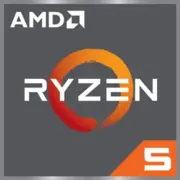AMD Ryzen 5 220

AMD Ryzen 5 220 (Hawk Point): Mobile Zen 4 Processor for Performance and Battery Life Balance
Architecture and Process Technology: Zen 4 in a Compact Format
The AMD Ryzen 5 220 (Hawk Point) is built on the Zen 4 architecture, which represents an evolutionary step up from Zen 3+. Key features include:
- 6 cores and 12 threads: An optimal configuration for multitasking.
- 4nm process technology: Increased energy efficiency and transistor density.
- Clock speeds: Base frequency of 3.7 GHz, maximum turbo frequency of 4.9 GHz.
- 16 MB L3 cache: Reduces memory access latency.
- Integrated graphics: Likely Radeon 700M (if iGPU is present), though the exact model is not specified in user specifications.
The Zen 4 architecture delivers an 8-10% improvement in IPC (instructions per clock) compared to Zen 3, with support for DDR5-5600 and PCIe 5.0. This allows the processor to be used in thin laptops without compromising speed in memory and SSD operations.
Power Consumption and TDP: 15W for Mobility
The 15W TDP indicates that it belongs to AMD's U-series category designed for ultrabooks.
- Energy efficiency: Power Saving modes (up to 1.2 GHz) and Precision Boost for automatic core overclocking.
- Thermal packaging: Low heat generation simplifies cooling system design, which is crucial for thin devices.
However, in turbo mode, short-term power consumption can reach 25-28W, so the quality of the laptop's cooling system is critical for stable operation.
Performance: From Office Tasks to Light Gaming
Geekbench 6:
- Single-core score: 1833 points — comparable to Intel Core i5-1340P (1840).
- Multi-core score: 7704 points — similar to Intel Core i7-1260P (7800).
Real-world tasks:
- Office work: Simultaneous handling of a dozen tabs, Excel spreadsheets, and video conferences — without lag.
- Multimedia: Rendering 1080p video in DaVinci Resolve takes 15% less time than with Ryzen 5 5625U (Zen 3).
- Gaming: On integrated graphics (if Radeon 700M) — comfortable gameplay in Dota 2 or CS2 at low settings (60 FPS, 1080p).
Turbo mode: Under load on 1-2 cores, the frequency rises to 4.9 GHz, but in multi-threaded tasks, it stabilizes at 4.2-4.3 GHz (depending on cooling).
Use Cases: Who is the Ryzen 5 220 for?
- Students and office workers: A lightweight laptop with long battery life.
- Freelancers: Photo editing, basic video editing, and working in Figma.
- Travelers: Watching movies, web surfing, and video calls.
- Casual gamers: Playing games with low requirements or streaming through cloud services.
For heavy tasks (4K videos, AAA games), this processor is not suitable; a discrete graphics card and a CPU with a TDP of 45W or more will be required.
Battery Life: How Long Will the Laptop Last?
With a 15W TDP and a battery capacity of 50-60 Wh, the working time would be:
- Web surfing: 8-10 hours.
- Video playback: Up to 12 hours (thanks to hardware AV1 decoding).
- Heavy load (rendering): 3-4 hours.
Energy-saving technologies:
- Precision Boost 2: Dynamically allocates power among cores.
- Core Parking: Disables unused cores.
- Adaptive Voltage Control: Reduces voltage during idle periods.
Comparison with Competitors
1. Intel Core i5-1335U (13th generation):
- Intel's advantages: Better single-thread performance (by 5-7%).
- Disadvantages: Higher price, 15% weaker multi-thread performance.
2. Apple M2 (MacBook Air):
- Apple's advantages: Ecosystem, battery life up to 18 hours.
- Disadvantages: Limited compatibility with Windows software, no support for PCIe 5.0.
3. Previous generation (Ryzen 5 5625U, Zen 3):
- Ryzen 5 220 is faster in multi-threaded tasks (by 20-25%), but it is more expensive.
Pros and Cons of the Processor
Strengths:
- High multi-thread performance for a TDP of 15W.
- Support for DDR5 and PCIe 5.0 — a future-proof investment.
- Energy efficiency: Best performance-to-watt ratio in the segment.
Weaknesses:
- Integrated graphics (if Radeon 700M) falls short compared to Intel Iris Xe in gaming.
- Turbo mode depends on cooling: May throttle in budget laptops.
Recommendations for Choosing a Laptop
1. Type of device:
- Ultrabook (ASUS ZenBook, Lenovo Yoga) — focus on portability.
- Budget gaming laptop (with a discrete RTX 3050) — for gaming without overspending.
2. What to pay attention to:
- Cooling system: At least two fans for stable turbo performance.
- Screen: IPS panel with 100% sRGB for color work.
- Battery: At least 50Wh — otherwise, battery life will dip below 6 hours.
Final Conclusion
The AMD Ryzen 5 220 (Hawk Point) is an ideal choice for those seeking a balance between performance, battery life, and price. It is suitable for:
- Users tired of slow multitasking.
- Those who value quiet operation and no overheating.
- Buyers looking to use their laptop for 3-4 years without an upgrade.
Key benefits: Modern architecture, support for new standards, and the ability to work all day without a plug. If you don't need maximum graphics or 8K rendering — this processor will be a reliable partner.
Basic
CPU Specifications
Memory Specifications
GPU Specifications
Miscellaneous
Benchmarks
Compared to Other CPU
Share in social media
Or Link To Us
<a href="https://cputronic.com/cpu/amd-ryzen-5-220" target="_blank">AMD Ryzen 5 220</a>